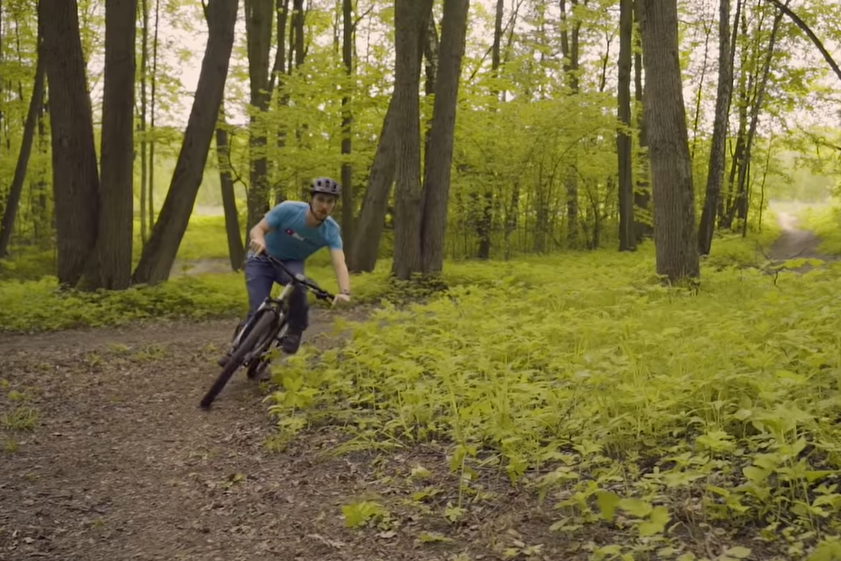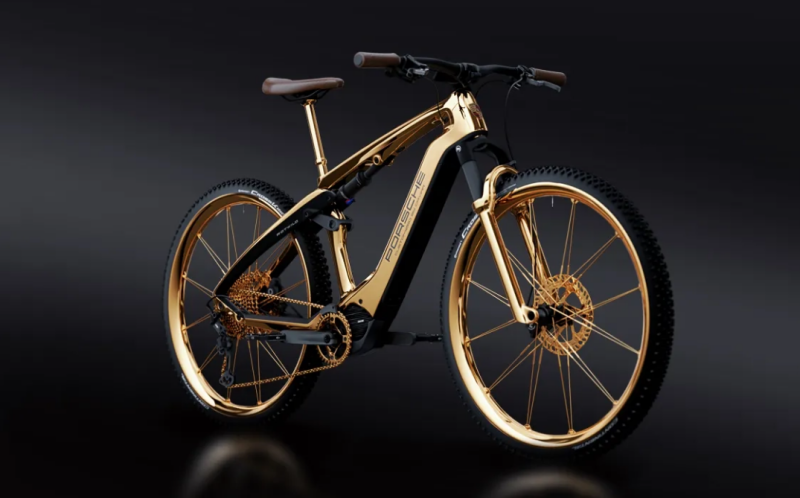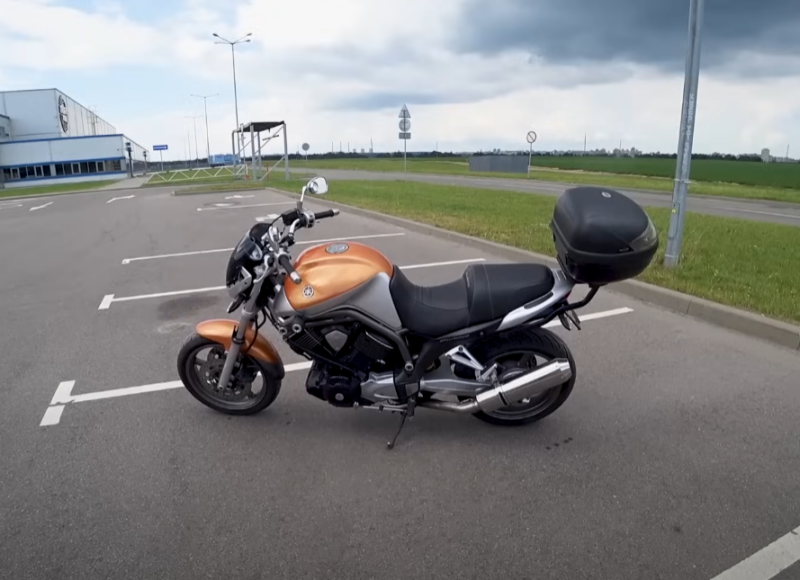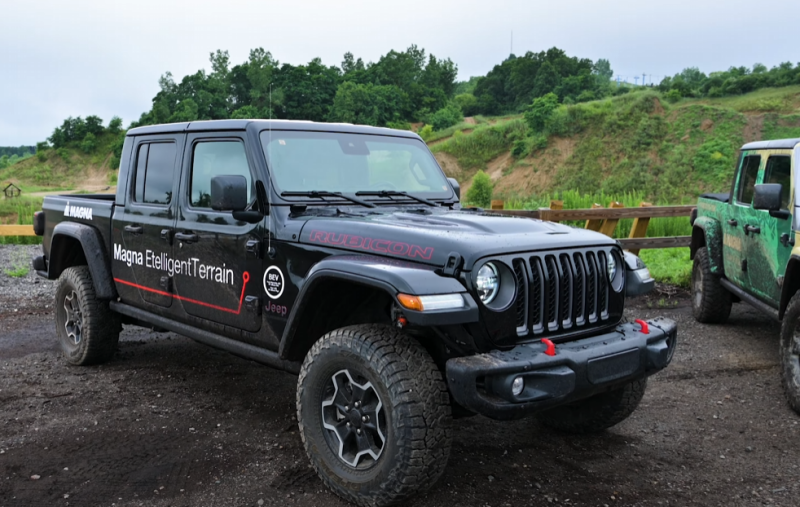Starting with turns
This skill is worth mastering as soon as you learn to ride in a straight line. Even if you ride around the nearest public garden, you will have to turn, not to mention more active movement around the city.
You should start with the simplest section. It should be spacious for confident and calm maneuver.
There are two main ways to make a turn - rudder and tilt:
✅ The first is used at low speed, and the second at high speed
✅ First you need to move slowly, practicing tight and short turns
✅ Then they move on to long and wide, gradually increasing speed
Before studying the technical aspects, it is useful to master one psychological point. It is important to look where the bike wants to go without clinging to foreign objects. The body will instinctively strive for a given point on which the gaze falls.
Leaping attention from potholes to nearby trees is likely to result in an unwanted collision or fall. Also, do not look under the front wheel.

Full equipment will give you a feeling of confidence during the first workouts. Photo: youtube.com
To practice, you need to adjust the level of pressure in the tires. The indicator should correspond to the nature of the coverage. But it is better to start with studying on asphalt: on a flat surface, a beginner feels confident. The soil has its own specifics, which are introduced later.
algorithm
The turn consists of three parts, and it is useful for a beginner to practice each one separately. When the skills are mastered at the reflex level, you can complicate the task.
The first part is the choice of the trajectory. It is important to calculate the radius so as not to enter the turn too sharply and quickly, as a beginner will certainly not be able to control the situation in all aspects.

If the arc is wider at the entrance, the exit will be easier: you won’t have to taxi. Photo: youtube.com
The next skill is timely braking. It is performed before entering the turn. After slowing down to a comfortable speed, you need to release the brakes and concentrate on balancing.
Next, they master the passing of the turn. At this stage, it is useful to squeeze into the bike, lowering the center of gravity. It is recommended to bend the knee of the leg, directed inward, down - it creates aerodynamic resistance, slowing down the movement. As you enter a turn, shift your weight onto the outside pedal to load the tire for better traction.

The key task for a beginner is to maintain balance by controlling the shift in the center of gravity. Photo: youtube.com
Having mastered the turn in one direction, they perform a similar task in a mirror manner. You can create artificial barriers by placing safe objects in the way - empty bottles or boxes.
How tilt works
To balance the center of gravity and get the bike on the right path, it is worth figuring out how low you need to lean. And for this you need an understanding of why the transport itself enters the turn even without the help of the steering wheel.

Do not jerk the steering wheel in a turn: the front wheel will lose traction. Photo: youtube.com
If the tires do not roll strictly vertically, the radius and circumference of the parts in contact with the road change. Therefore, the bicycle itself begins to ride in an arc. The stronger the slope, the smaller the radius - this way the trajectory is adjusted.
Cornering styles
Having figured out how to turn with the steering wheel and tilt, you can move on to high-speed maneuvers. They are performed in several ways.
A classic of the genre - the cyclist deviates along with the bike, being its continuation. That is, the angle of inclination is the same for a person and for a vehicle.
However, on dry, clean pavement or on soft ground, when the adhesion of the tires to the coating is high, it is possible to pass the turn at an accelerated rate. To do this, the bike is tilted more, the center of gravity is shifted to the outside of the turn, and the body remains almost vertical.

With the added tilt of the bike, mobility is increased and skidding is made easier. Photo: youtube.com
For wet and slippery roads, there is a technique. With low traction, the bike is held almost flat and the body leans inward. The foot aimed at the center is relegated to the side and serves as a balancer. The frame is pressed with the outer thigh as needed. On a difficult surface, it is important to unload the “inner” leg so that it is ready to straighten and substitute it in order to avoid falling.
We drive through mud and loose surfaces
Riding around the city, cyclists do not encounter difficult sections for years. However, it is useful to know the technique of passing them at least in theory. It can come in handy if you want to get out with friends in the nearest forest.
First you need to say goodbye to the false prejudice that supposedly muddy areas are insurmountable if narrow tires are installed. The task becomes more complicated, but doable if you know the intricacies of technology.
A lot depends on coverage. The most difficult is with an admixture of clay, as it is sticky, clings to the tires, making the bike heavier and restricting movement.

You don’t drive into liquid mud at high speed: it takes the front wheel away, and the bike falls. Photo: youtube.com
Basic rules for overcoming muddy areas and terrain with loose surfaces:
? You should choose a speed that guarantees that you will not lose control
? It is important to control the balance, keeping the body relaxed
? You need to move evenly, without increasing power, but without stopping pedaling.
It is doubly difficult for beginners to keep calm and good spirits, feeling how the tires are loaded. At such moments, you do not need to accelerate or give up pedaling. If it starts to “suck in”, they switch to a low gear, but continuing to work with their feet. The bike will move very slowly, but will not fall over.
It is also important to constantly control the steering wheel. To prevent the front wheel from going to the side, it is better to actively move it.
The subtleties of the ride
For the first time leaving on the mud, beginners involuntarily get nervous, if only for the reason that they do not want to fall into an unpleasant muck. The task is complicated by the fact that you need to act according to the situation - the technique is adjusted to specific circumstances. Riding style varies depending on the density of the ground and other characteristics. It is doubly responsible to regulate the speed, steering, body position, if there are turns, ups and downs in the muddy area - all this complicates the task.

For greater confidence, it is better to load the rear wheel. Photo: youtube.com
We must not forget that the mud is insidious - it often hides stones, roots, potholes. It is especially dangerous if the bike “bites” into a hole that is invisible from the outside.
The general recommendation for mud riding is that every movement should be smooth. You can not pedal sharply, turn the steering wheel. Even the body should be kept under control, gently changing its position as needed.
So which tires are best?
Finally, let's figure out how tires affect patency if you have to drive through a muddy area.
✅ If there is mud ahead, you can move confidently even on a road bike. The narrow wheel cuts through the mud, resting on a hard layer. But on a wide tire there is no such confidence - it slides on the surface
✅ In loose sand, a narrow wheel is buried, sometimes it gets stuck so tightly that you have to dismount. On wide tires, the cyclist slowly moves forward
That's all the tips to help you master the science of cornering and overcoming mud. But it is still better to move from theory to practice in order to master the material and work out techniques at the level of reflexes.










